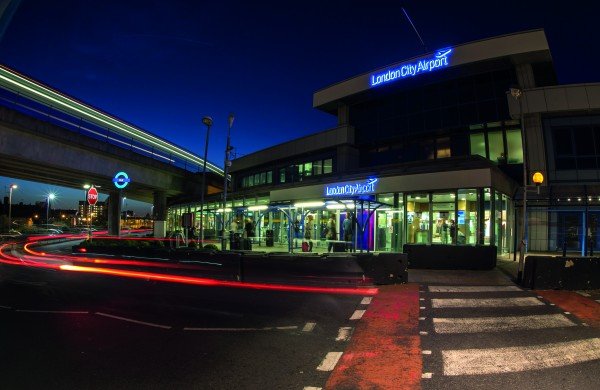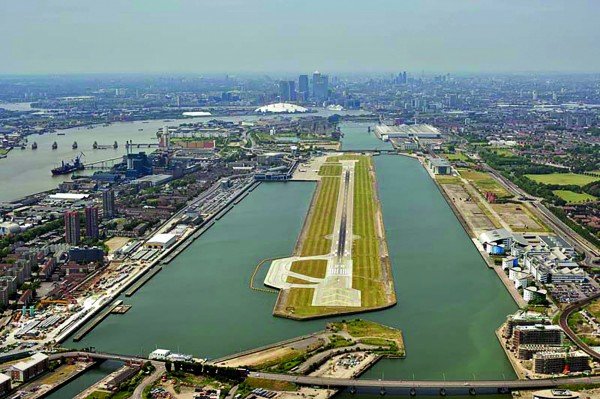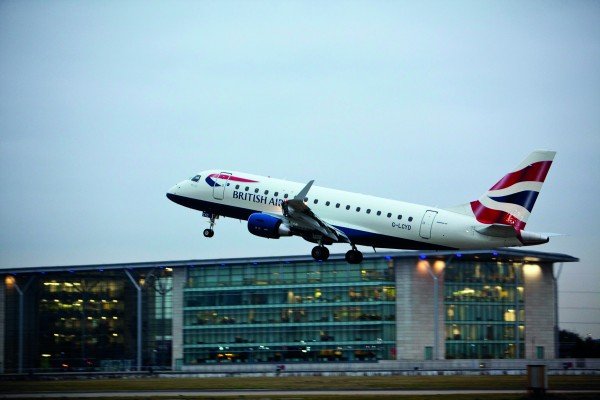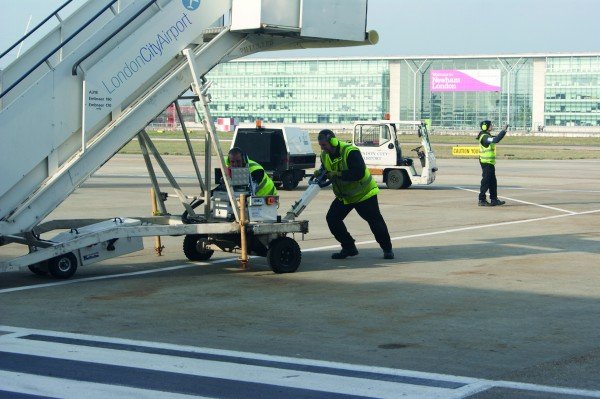
With a career in aviation spanning 28 years, Sharon Preston has held a wide variety of roles. She talks to Carrie Stewart about her latest role at London City Airport and the safety challenges that the busy international terminal brings.
Sharon Preston laughs when she remembers her response: “What do I know about health and safety?” It was back in 2010, and she’d been tasked to take on the challenge of turning around London City Airport’s health and safety culture.
With no health and safety qualification, it may have seemed an odd choice, but Sharon was no stranger to taking on new roles. Having started at the airport as a part-time information assistant in the terminal, she steadily took on more responsibility, from starting an airfield operations department to moving to general manager of security. She’s currently director of safety and airfield operations.
Common sense approach
 Coming into the role with fresh eyes, Sharon could see that, as a business, the airport wasn’t where it needed to be in terms of health and safety. They weren’t capturing a lot of data and it was difficult to see where the main problems were. And although Sharon didn’t have much experience in health and safety, she didn’t see this as holding her back.
Coming into the role with fresh eyes, Sharon could see that, as a business, the airport wasn’t where it needed to be in terms of health and safety. They weren’t capturing a lot of data and it was difficult to see where the main problems were. And although Sharon didn’t have much experience in health and safety, she didn’t see this as holding her back.
“To me, health and safety is about common sense,” she says. “I had a health and safety advisor at the time, and he had a lot of knowledge and qualifications, and knew the regulations inside out. In a lot of ways it worked, because I would say ‘Well, what do the regulations say?’ and he’d tell me. I’d put my common sense hat on, and then put that into place.”
There were still occasions, she says, where she would question whether the regulations were really saying something specific, or if it was down to interpretation, but it worked well, and she was able to challenge the interpretation of some of the regulations in a way that worked for the airport.
But there was still the issue of getting the safety message across to the airport’s staff, which, on a day-to-day-basis, is over 2,000 people. Besides the 600 airport staff members, the rest are comprised of handling agents, fuellers, catering companies, cargo handlers, cleaners and concessions that deal with shops and outlets.
“The challenge for me really was how do we change the culture here?” Sharon quickly realised that this was going to take some time to do properly, but the COO at the time wanted it ‘done and dusted’ in a year.
Sharon disagreed. If they were going to do it properly, and with some validation, it wasn’t going to happen overnight. She had read an article about DuPont taking five years to turn around its safety culture, and could understand why.
“I think health and safety is seen by a lot of people as some sort of black art, that it wants to stop everything,” she says.
“Trying to get people to understand that it’s not about that, it’s about ensuring you’re safe, that you can come to work and go home in the same state every day. It was gradually getting out that message.”
Cake & Safety
 One of the initiatives Sharon started was Cake & Safety. She hoped to get more people involved with safety culture at a personal level.
One of the initiatives Sharon started was Cake & Safety. She hoped to get more people involved with safety culture at a personal level.
“And what better way to entice people into attending something than offering them free cake and tea and coffee?”
Beginning in 2011, Sharon ran one or two events a year, involving everyone from emergency planning, airfield ops, health and safety, fire service, and environment. Each team would set up a little area and try to pass on knowledge in an interesting way, so it wasn’t like sitting in a classroom or being preached to.
“As soon as you say health and safety people go ‘Uh’, and you see them roll their eyes, no interest whatsoever,” she says. “So we thought we need to make it interesting, and capture people’s imagination.”
This included having quizzes around health and safety questions and showing videos, playing games, while “all the time subliminally feeding in these messages that safety is a good thing, and safety is something that should be important to you as well,” she adds. “Since then we have gone on to run safety road shows where members of the team go to the areas of work and focus on key issues. This ensures we get maximum exposure to the staff.”
Another way London City Airport spreads the health and safety message is to focus on the positive rather than the negative. As part of a drive to promote a just culture, in 2014 the airport introduced a scheme called Pro Points and SAFE (Safety Achievement for Excellence), which tries to encourage people to report their colleagues and themselves if something goes wrong.
 “A lot of the time it’s not always the individual’s fault,” she explains. “Sometimes it’s an organisational failing, or the way the job is designed, so there are all these other aspects about why an accident happens.”
“A lot of the time it’s not always the individual’s fault,” she explains. “Sometimes it’s an organisational failing, or the way the job is designed, so there are all these other aspects about why an accident happens.”
The Pro Points scheme helps to build a proper picture of how incidents happen, rather than just capturing the obvious. At the end of each month they review the reports that have received Pro Points and the ones that have shown the most positive demonstration of safety awareness or safety culture are issued with a SAFE certificate. At the end of the year, they review the SAFE winners and the most outstanding contribution will receive an iPad. It’s an incentive that helps the airport learn why things go wrong.
“We’re seeing people when they do silly things that we wouldn’t necessarily have known about, but now we do,” she says. “Which then prompts questions – why did you do it, and trying to understand the details beneath why these sorts of things happen.”
Human factors play a big part in the overall safety picture at the airport and are key to understanding why accidents happen and what can be done to prevent them.
One of the biggest issues at the airport is manual handling. Ramp staff climb in and out of small spaces, which aren’t designed for people, and it can be a challenge to meet regulations without grinding the whole operation to a halt. The aircraft have to turnaround in 30 minutes, so speed is imperative, but there needs to be a balance between that and staff health and safety.
Reality check
Back in 2010 the airport received a reality check in the form of an improvement notice from HSE for manual handling. In response, they brought in Pristine Condition, a company run by former weightlifters who use weightlifting techniques to teach how to lift correctly. The intervention proved a success, with a 66 per cent reduction in manual handling injuries from 2010-2014.
 “But even so we still have our challenges,” Sharon adds. “Low holds, trying to get people into a comfortable position to move bags without twisting and doing what they shouldn’t be doing is still a tough one. But we’ve had brilliant results.”
“But even so we still have our challenges,” Sharon adds. “Low holds, trying to get people into a comfortable position to move bags without twisting and doing what they shouldn’t be doing is still a tough one. But we’ve had brilliant results.”
Sharon stresses that getting across the health and safety message isn’t just about reaching front-line staff, it needs to start with managers and supervisors.
“And with the best will in the world, they aren’t always necessarily looking at the safety aspects of what the team are doing,” she says. “They’re more focused on are they getting the job done? So again, that’s been another big change for us, actually getting the supervisors and team leaders to not just think about the job, but how they’re trying to achieve it. Is what they’re doing safe and not cutting corners, because if they are then maybe we need to redesign the task.”
Operational drift
This leads into what Sharon calls ‘operational drift’. A process may be put in place for how a task should be carried out, but if it’s not working for the people doing the job, gradually it will drift, and that’s where corners can be cut and accidents happen. Sharon says they’ve done a lot of work looking into how they do things at the airport to make sure it works for everyone.
“I think that’s important, because it’s very easy for managers to sit in an office and say we’ve got this piece of kit, this is how we do it.” Instead, they now get a team together, carry out the risk assessment as a group, and discuss the best way to achieve it. All staff members are included as they’re the ones who are going to be doing the job. And, as Sharon says, “Who better to ask than the ones on the ground?”
A shift in an organisation’s safety culture doesn’t happen overnight, but it’s something Sharon is passionate about getting across to all staff members.
“We’re trying to get people to accept the fact that health and safety isn’t a bolt-on; it isn’t something you just sort of think about after the job,” she argues. “It’s actually part of the job. It’s integral to whatever they’re doing. I’d say it’s the same for most businesses. It’s getting people to see that health and safety isn’t owned by the health and safety team. We can’t solve everybody’s problems for them. It’s everyone’s responsibility, and getting them to take ownership for that.”
With the Cake & Safety initiative a continuing success, and an increase in reporting and reduction in manual handling injuries, you’d think Sharon would be satisfied. But she’s not resting on her laurels just yet.
“We’ve come a long way, but we’re still not 100 per cent where I’d say yes, we actually have the best safety culture in a UK airport, because I don’t think we have. I think we’ve come a long way but there’s still a way to go.”
The Safety Conversation Podcast: Listen now!
The Safety Conversation with SHP (previously the Safety and Health Podcast) aims to bring you the latest news, insights and legislation updates in the form of interviews, discussions and panel debates from leading figures within the profession.
Find us on Apple Podcasts, Spotify and Google Podcasts, subscribe and join the conversation today!






